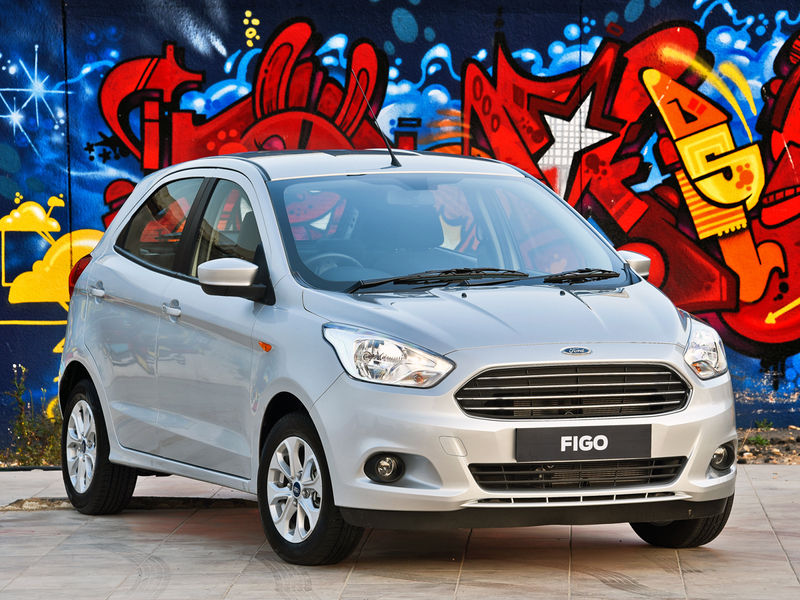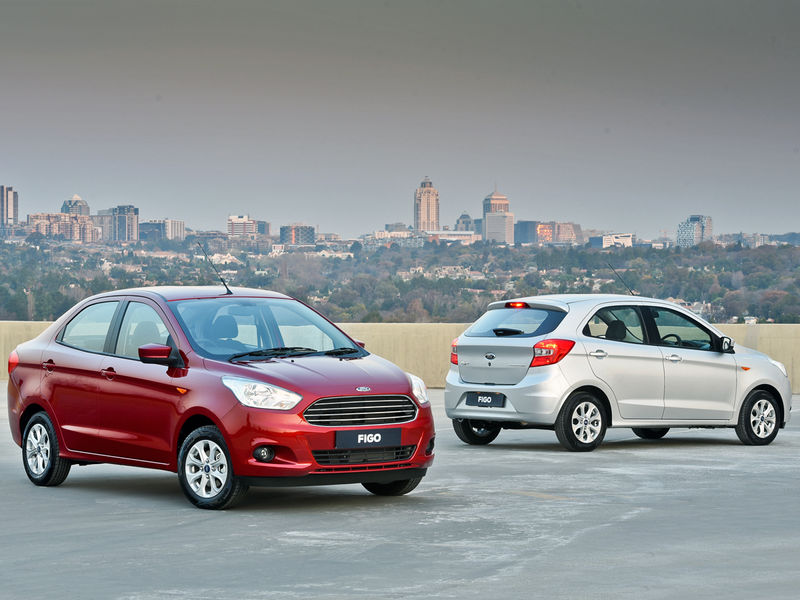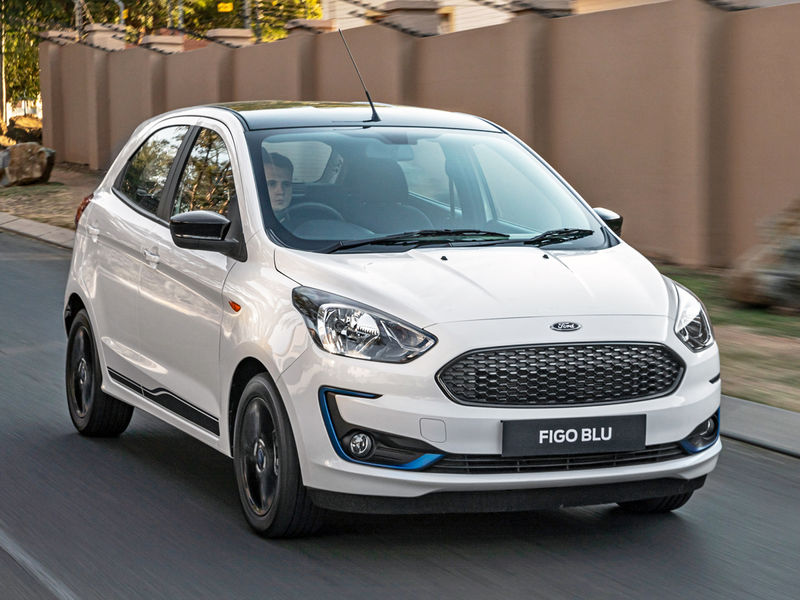Are you thinking about buying a 2nd-gen Ford Figo? This article lists the Indian-built budget car’s pros and cons, which derivatives were available in South Africa and what you can expect to pay for a good used example of the Blue Oval’s model …
While the original (B517-gen) Ford Figo was a strong seller in Mzansi during its 5-year tenure, there was no denying it was little more than a rebadged 5th-gen Fiesta. However, with the 2nd iteration (which was known internally as the B5620), the Blue Oval brand shifted away from the prolonged-lifecycle approach.
Though it was again based on a platform shared with the Fiesta and also produced in India, this time the Figo range incorporated both 5-door hatchback and 4-door sedan body styles. It furthermore boasted a unique body shell (adorned with a Fusion-inspired grille), more powerful engines and fresh technology.

Bearing in mind that, unlike its predecessor, the 2nd-gen Figo was not a continuation model that the Blue Oval could bring to market highly cost-effectively, the Ford Motor Corporation of Southern Africa (then the country’s 3rd biggest automaker) was compelled to position the model somewhat more upmarket than before. When it debuted, it was thus sited towards the sharp end of the so-called sub-B-segment.
Though the Figo remained the entry point to Ford ownership, there was an appreciable hike in pricing, with the gap to the Fiesta thus narrowing markedly. This, in turn, ultimately saw the base Ambiente trim being dropped from the Fiesta line-up when the 7th-gen model made its local debut in May 2018.

Just how popular was this model in the local market? Well, in 2020, the Figo placed 12th on the list of South Africa’s best-selling passenger cars in the new-vehicle market (with 4 906 units registered that year). Although it was not a weak effort, that number put the Ford model behind segment rivals such as the Volkswagen Polo Vivo (19 750 units), Toyota Etios (5 806 units) and Suzuki Swift (5 507 units).
Production of the 2nd-gen Figo ended at the company’s Chennai and Sanand factories in 2021, with stock running dry in South Africa around the 2nd quarter of 2022. The Figo’s local demise followed shortly after that of the Fiesta (with the EcoSport, likewise, being put out to pasture a little later), effectively reducing Ford SA’s passenger-vehicle line-up (at the time) to the Mustang and Everest.
Ford Figo line-up in South Africa

The Figo – which was badged as the Ka or Ka+ in some overseas markets – was revealed in production sedan form (wearing the “Aspire” badge) in India in May 2015, although a hatchback concept had been unwrapped in Brazil as far back in November 2013.
In October 2015, the 2nd-gen Figo arrived in South Africa, with the range comprising 6 hatches and 3 sedans. Buyers had the choice of a pair of 1.5-litre, 4-cylinder engines (a naturally aspirated petrol or a turbodiesel unit, each driving the front axle) and 2 transmissions (a 5-speed manual or a 6-speed dual-clutch automatic). With 3 trim levels on offer, the 9-strong line-up looked like this at launch:
- 1.5 Ambiente hatch 5MT (82 kW/136 Nm)
- 1.5 Ambiente sedan 5MT (82 kW/136 Nm)
- 1.5 Trend hatch 5MT (82 kW/136 Nm)
- 1.5 Trend sedan 5MT (82 kW/136 Nm)
- 1.5 Titanium hatch 5MT (82 kW/136 Nm)
- 1.5 TDCi Ambiente hatch 5MT (74 kW/215 Nm)
- 1.5 TDCi Trend hatch 5MT (74 kW/215 Nm)
- 1.5 Titanium hatch 6DCT (82 kW/136 Nm)
- 1.5 Titanium sedan 6DCT (82 kW/136 Nm)
The local Figo range continued unchanged until May 2018, when the Dearborn-based manufacturer’s local subsidiary introduced a refreshed version of the model. The facelift included the requisite styling tweaks and interior upgrades, as well as a longer standard service plan, plus a new engine (used across the range) and automatic transmission. There was also a clever “device dock” positioned in the upper section of the centre console, which could be used to connect and power smartphones.

Interestingly, the fuel-frugal 1.5 TDCi turbodiesel mill fell away at this point, while the 1.5-litre, 4-cylinder petrol unit was replaced by a new (also atmospheric/non-turbocharged) 3-cylinder petrol engine of the same displacement (offering outputs increased to 88 kW and 150 Nm). While the 5-speed manual gearbox was carried over, the problematic PowerShift-branded dual-clutch transmission was ditched in favour of a conventional 6-speed torque-converter automatic. In addition, the range was pared back to 5 derivatives (3 hatches and 2 sedans), temporarily featuring only the Ambiente and Trend grades.
In December 2018, the high-spec Titanium trim returned to the line-up, though it was offered only in conjunction with the hatchback body style and, somewhat curiously, a manual ‘box. Highlights of the flagship included a 6.5-inch touchscreen (running the latest Sync3 software), a reverse-view camera, extra safety kit and Ford MyKey, a feature that allowed owners to programme a key for “younger drivers” to inhibit incoming phone calls, restrict the top speed and reduce the audio system’s maximum volume.

A special-edition Figo Blu appeared in mid-2019, based on the Figo 1.5 Trend hatch and limited to 360 units. It scored a black mesh grille, blue front-bumper trim, black 15-inch multi-spoke alloys, black side-mirror caps, a black roof and stripes down its flanks. Inside, the Figo Blu featured gloss-blue door inserts, blue gearshift-gaiter stitching, embroidered front floor mats and a leather-wrapped steering wheel.
Finally, after Ford had quietly hiked the 1.5 Ti-VCT 3-pot’s maximum power output from 88 kW to 91 kW, the Figo Freestyle cross-hatch slotted in at the top of the line-up in June 2020. Available in mid-tier Trend and top-spec Titanium forms (and exclusively with a manual gearbox), the Freestyle was billed as a “compact utility vehicle”. It featured a 190-mm ground clearance, bigger wheels (15-inch alloys shod with 175/65 tyres) and “SUV-derived” styling cues (including black body cladding, roof rails and skid-plates, fore and aft).
What are the advantages of a Ford Figo?

Peppy and potentially frugal engines: The 1.5 TDCi (DV5) engine offered in the pre-facelift Figo hatch was a particularly tractable motor – delivering its peak torque (215 Nm) from 1 750 to 3 000 rpm (and thus boasting sprightly in-gear acceleration). Of course, the little turbodiesel unit also had the potential to return impressive fuel economy, with Ford quoting a combined figure of just 4.1 L/100 km.
On the naturally aspirated petrol front, the 1.5 Ti-VCT “Dragon” engine that powered all facelifted Figo derivatives may have been down a cylinder compared with the old 1.5-litre Sigma motor it replaced, but it offered more grunt and felt far livelier (while sipping a claimed 5.7 L/100 km in manual guise; an improvement over the old engine’s stated figure of 5.9 L/100 km). Despite featuring an odd number of cylinders, it was a surprisingly smooth-revving motor.

Commendable ride comfort: Since the Figo was set up to cope with India’s notoriously poor road infrastructure, it offered an absorbent ride quality with damping that felt a little more resolved than you might expect from contenders at this end of the market. Featuring a semi-independent twist-beam suspension arrangement at the rear and generous ground clearance of 174 mm, the B562 series furthermore benefited from high-profile tyres (175/65 on all derivatives, regardless of whether 14- or 15-inch alloys were fitted). Freestyle variants, meanwhile, enjoyed an extra 16 mm of ride height.
Pair of body styles (plus a cross-hatch): While the original Figo was available exclusively as a hatchback, the 2nd-generation range also included a sedan option, which offered an appreciably bigger boot with a claimed 445-litre capacity (and stretched a further 368 mm from nose to tail). The addition of the Freestyle cross-hatch later in the model’s lifecycle broadened the Figo’s appeal even further.
What are the disadvantages of a Ford Figo?

A few safety anomalies: Budget cars are hardly ever equipped with myriad standard safety features, but the 2nd-gen Figo did lack a few notable items. All derivatives did without ISOfix child-seat anchors, while the centrally seated rear passenger had to make do with a lap belt. In addition, it’s worth noting only Titanium derivatives featured a complement of 6 airbags, with all others settling for dual front items.
What’s more, the only derivatives in the pre-facelift range to score electronic stability control were the auto-equipped Titanium versions, which further featured hill-launch assist. Similarly, in the facelifted line-up, only the self-shifting Trend hatchback came with traction control (and hill-launch assist).
Though specifications varied by market, the Figo’s crash-test results were a mixed bag, with the Indian-built sedan being awarded 3 stars by Global NCAP in 2017 (a score matched by the Ka+ hatch in its Euro NCAP evaluation) and the Brazilian-built version chalking up zero stars from Latin NCAP later that year. The facelifted model, however, redeemed itself with a 4-star rating from Latin NCAP in 2019, although, the version offered in South America at that stage was, interestingly, sourced from India.

Some ergonomic foibles: Although the Figo was largely enjoyable to drive, there were a few ergonomic issues. For instance, manual versions lacked a footrest to the left of the pedal box, while the clutch had an unusually high biting point. The steering wheel, meanwhile, was devoid of satellite controls (bar on the flagship Titanium derivative) and the steering column could only be adjusted for rake, not reach.
While the rear bench in the Ambiente hatch and all sedan derivatives could fold down, it did without a 60:40-split function, which the more expensive derivatives were equipped with. In addition, since the hatchback maximised rear passenger space at the expense of luggage capacity, its claimed 256-litre load-bay capacity was below the class average (and even tighter than that of the original Figo!).
PowerShift problems (pre-facelift): Titanium versions of the pre-facelift Figo employed the maligned PowerShift dual-clutch automatic transmission, which was known to suffer from leaking seals that led to oil contamination of the dry clutch module (resulting in juddering and jerky acceleration). Thankfully, the Blue Oval switched to a conventional 6-speed torque-converter automatic at the mid-cycle refresh.
For the record, the engines themselves seemed to have few inherent issues – provided they were well cared for, of course. The newer 3-cylinder petrol motor, in particular, would have appealed to buyers wary of going the downsized, turbocharged route. The only other possible issue we discovered was that Figo derivatives built between September 2017 and April 2019 were recalled in India for a potentially defective battery monitoring system (BMS) wiring harness.
How much is a Ford Figo in South Africa?

Whereas the pre-facelift Ford Figo featured a 2-year/40 000 km service plan, the refreshed model upgraded to a 4-year/60 000 km arrangement. That’s great news for those shopping for a late-model example, which would – at the time of writing, at least – still enjoy some cover. Regardless, always give preference to models featuring a full, verifiable maintenance history.
Of the used 2nd-gen Ford Figo listings on Cars.co.za at the time of writing, a whopping 85% took the form of hatchback variants (10% of which were Freestyle derivatives). More than 96% featured a petrol engine, while just 7% were equipped with an automatic transmission.
Mileage varied from a mere 10 km through to 233 000 km, with the latter achieved by a 2019 1.5 Ti-VCT Ambiente hatch. We found a further 4 examples with more than 200 000 km on their odometers. White (60%) was the most popular paint colour, followed by silver (19%), grey (5%) and red (4%).
- Below R100 000: While there were very few options below this point, all were – rather unexpectedly – facelifted models. Still, we’d advise treading particularly carefully here; should a deal appear too good to be true, it probably is.
- From R100 000 to R150 000: All model years bar the first and last were represented here, though the most common were 2018 and 2019. We found low-spec, sub-50 000 km facelifted examples in this bracket, along with a higher-than-average distribution of the less-popular sedan body style.
- From R150 000 to R200 000: At the time of writing, this was easily the most densely populated pricing bracket, comprising almost exclusively facelifted examples (with the 3-cylinder engine thus dominating). Fascinatingly, though, we discovered very few Titanium-spec vehicles here.
- R200 000 and up: Spending upwards of R200k would get you a late model-year Figo, with the choice of the mid-tier Trend or top-spec Titanium grades. This pricing segment was also where we found most Freestyle derivatives, which accounted for nearly 40% of Figo listings above this mark.
Which Ford Figo derivative should I buy?

So, which derivative is the best of the bunch? Well, if you’re in the market for a turbodiesel Figo, you’d be limited to the pre-facelift hatchback. Here, we’d opt for the Trend trim level as Ambiente was perhaps a little too basic for most needs. Of course, bear in mind there aren’t many oil-burning B562-series Figo examples around; precious few of all listings on Cars.co.za (at the time of writing) feature this engine.
We suspect most buyers will be looking for a petrol-fed example and probably favour the hatch over the sedan variant. In that case, we’d recommend searching for a facelifted model, as the 3-cylinder engine offered more poke – not to mention character and, potentially, fuel economy – than the earlier 4-pot.
For the hatch (and Freestyle), the flagship Titanium specification would be first prize considering its lengthier list of standard features, which included a more comprehensive infotainment system, an uprated instrument cluster, automatic headlights, rain-sensing wipers, four extra airbags and more. However, the Trend grade would also be worth considering and would be a bit easier to come by, too.
Is the Ford Figo a good used buy?

In its day, the Ford Figo had a few tough sub-B-segment rivals with which to contend, from the locally produced and incredibly popular Volkswagen Polo Vivo to the Indian-built Toyota Etios and Suzuki Swift (both the AZG and A2L generations, including the Dzire sedan). The B52-gen Renault Sandero – which has since been replaced by the Kiger in the local market – was another spacious hatchback alternative and the only one here that used a downsized turbopetrol engine.
Meanwhile, the Figo Freestyle competed in an interesting cross-hatch sub-segment that included contenders such as the Volkswagen Polo Vivo Maxx (and even the smaller, classy Cross Up), the Toyota Etios Cross, the Renault Sandero Stepway and perhaps even the little Suzuki Ignis.
So, does the B562-series Ford Figo make a sensible 2nd-hand buy? Well, although the 2nd-gen model wasn’t quite as compelling a value proposition as its prolonged-lifecycle predecessor, there’s no doubt it was a more accomplished product. And, with the nameplate now discontinued, the Figo appears to be clawing back some of that value on the used market, making it an increasingly attractive option.




